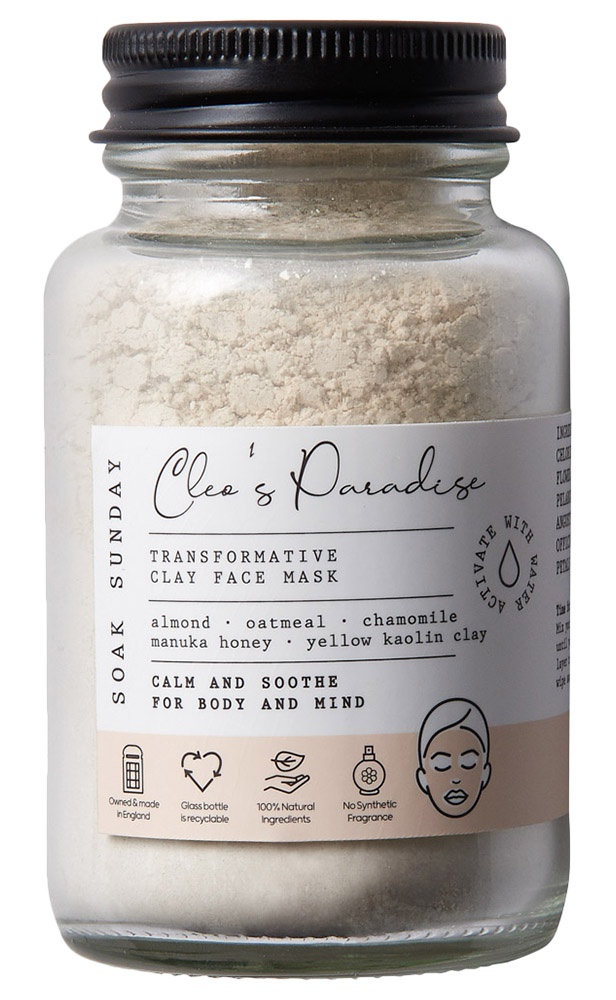
Cleo's Paradise Transformative Clay Face Mask
Highlights
Key Ingredients
Skim through
| Ingredient name | what-it-does | irr., com. | ID-Rating |
|---|---|---|---|
| Kaolin | colorant, abrasive/scrub | 0, 0 | goodie |
| Illite | abrasive/scrub | ||
| Avena Sativa (Oat) Kernel Flour | soothing, antioxidant, emollient | goodie | |
| Chamomilla Recutita (Chamomile) Flower Powder | |||
| Prunus Amygdalus Dulcis (Sweet Almond) Oil | emollient | 0, 1-3 | goodie |
| Anthemis Nobilis (Chamomile) Flower Oil | soothing, perfuming | goodie | |
| Leptospermum Scoparium (Manuka) Oil | antimicrobial/antibacterial, antioxidant | goodie | |
| Citronellol | perfuming | icky |
Soak sunday Cleo's Paradise Transformative Clay Face MaskIngredients explained
Kaolin is a type of clay or to be precise, a naturally occurring hydrous aluminum silicate. When you hear clay, you probably think of a muddy greenish-black mess, but that one is bentonite, and this one is a fine, white powder. It is so white that it's also often used, in small amounts, as a helper ingredient to give opacity and whiteness to the cosmetic formulas.
As a clay, it's absorbent and can suck up excess sebum and gunk from your skin, but less so than the more aggressive bentonite. As it's less absorbent, it's also less drying and gentler on the skin, so it's ideal for dry and sensitive skin types.

A finely powdered form of Oat Extract that has the same skin soothing, skin protecting and antioxidant benefits we have written about at Avena Sativa Kernel Extract. It is loaded with skin-goodies such as anti-inflammatory agent beta-glucan, skin nourishing lipids, and moisturizing carbohydrates. A real goodie for dry, irritated, inflamed or eczema-prone skin.

The emollient plant oil that comes from almonds. Similar to other plant oils, it is loaded with skin-nourishing fatty acids (oleic acid - 55-86% and linoleic acid 7-35%) and contains several other skin goodies such as antioxidant vitamin E and vitamin B versions.
It's a nice, basic oil that is often used due to its great smoothing, softening and moisturizing properties. It's also particularly good at treating dry brittle nails (source).
The essential oil coming from the second most common type of chamomile, the Roman Chamomile. It also contains the biologically active anti-inflammatory components, bisabolol, and chamazulene, but less than the more commonly used German Chamomile. It's not clear what Roman Chamomile knows that the German one does not.
The essential oil coming from the Manuka tree native to New Zealand. It is distantly related to the Australian Tea Tree Oil, although their chemical composition is very different.
The main antibacterial active in tea tree oil is terpinen-4-ol (40%), while manuka's main actives are so-called cyclic triketones, such as Leptospermone, Iso-leptospermone, and Flavesone (20-30%). Both oils are antibacterial and antifungal but in different ways.
While tea tree oil is a pretty well established anti-acne ingredient, manuka has more of a "might be useful" status for problem skin. Its strong suit is treating fungal infections such as athlete's foot, nail bed infections or foot odor. Other than that, manuka can help to relax muscles (useful for treating muscle and joint pain) and also has some antioxidant activity.
Citronellol is a very common fragrance ingredient with a nice rose-like odor. In the UK, it’s actually the third most often listed perfume on the ingredient lists.
It can be naturally found in geranium oil (about 30%) or rose oil (about 25%).
As with all fragrance ingredients, citronellol can also cause allergic contact dermatitis and should be avoided if you have perfume allergy. In a 2001 worldwide study with 178 people with known sensitization to fragrances citronellol tested positive in 5.6% of the cases.
There is no known anti-aging or positive skin benefits of the ingredient. It’s in our products to make it smell nice.
You may also want to take a look at...
| what‑it‑does | colorant | abrasive/scrub |
| irritancy, com. | 0, 0 |
| what‑it‑does | abrasive/scrub |
| what‑it‑does | soothing | antioxidant | emollient |
| what‑it‑does | emollient |
| irritancy, com. | 0, 1-3 |
| what‑it‑does | soothing | perfuming |
| what‑it‑does | antimicrobial/antibacterial | antioxidant |
| what‑it‑does | perfuming |





